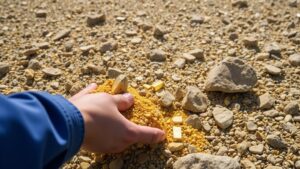Techniques for Tracing Copper Veins Through Surface Float Rock
Techniques for Tracing Copper Veins Through Surface Float Rock
Copper mining has been a cornerstone of industrial development, and understanding how to effectively trace copper veins in surface float rock is essential for exploration geologists. This article delves into the techniques that can be employed to identify and confirm the presence of copper mineralization, ensuring efficient and cost-effective exploration practices.
Understanding Surface Float Rock
Surface float rock comprises minerals and materials that have weathered, eroded, and been transported from their original source. In contexts where copper is present, float rocks may contain secondary copper minerals such as malachite and azurite, which are indicators of underlying copper veins. Identifying and analyzing these rocks is a preliminary step in exploratory geology.
Techniques for Tracing Copper Veins
Effective tracing of copper veins through surface float rock requires a combination of fieldwork, analytical techniques, and data interpretation. Below are several key techniques employed by geologists:
- Geological Mapping: Mapping the distribution of float rocks provides insights into the geological context. This technique helps in understanding the structural and stratigraphic settings, allowing geologists to predict where copper veins may be located.
- Geochemical Analysis: Testing surface float rock samples for their chemical composition can yield critical information. For example, spectrochemical analysis and X-ray fluorescence (XRF) can quantitatively measure the concentration of copper and associated elements.
- Geophysical Surveys: Techniques such as electromagnetic (EM) and induced polarization (IP) surveys can detect variations in the physical properties of subsurface materials. For example, areas with higher conductivity might correlate with copper deposits.
- Remote Sensing: Utilizing satellite imagery and aerial photography can aid in identifying surface features that may indicate mineralization, such as discoloration or alterations in vegetation.
- Sample Collection and Analysis: Collecting float rock samples in areas showing anomalies and analyzing their mineral content and structure can lead to direct indications of nearby copper sources.
Case Study: The Los Colores Project
In the Los Colores Project in Northern Chile, a systematic approach combining geochemical analysis and geophysical surveys has been critical in tracing copper veins. Initial sampling of float rocks revealed high concentrations of oxidized copper minerals, which led to further detailed mapping and surface sampling.
The combination of EM and IP data successfully identified conductive anomalies beneath the surface, guiding drilling operations that confirmed the presence of a substantial copper deposit at depth. This case exemplifies the effectiveness of integrating diverse techniques to maximize exploration success.
Challenges and Considerations
Despite advancements in technology and methodology, several challenges persist in tracing copper veins through float rock:
- Variability in Surface Composition: Surface float may consist of different materials due to weathering, making it difficult to pinpoint the source.
- Overburden Cover: Drift or soil cover may obscure direct access to the mineralization, necessitating more extensive exploration techniques.
- Human Error in Sampling: Misinterpretation of surface features or inadequate sampling can lead to overlooked deposits.
Addressing these challenges requires careful planning, a thorough understanding of local geology, and possibly the integration of innovative technologies, such as machine learning algorithms in geospatial analysis.
Conclusion and Takeaways
Tracing copper veins through surface float rock is a multifaceted process that amalgamates geological mapping, geochemical analysis, geophysics, and remote sensing. Successful copper exploration often hinges on the ability to amalgamate these techniques effectively.
As shown in the Los Colores Project, an integrated approach not only enhances the accuracy of locating copper veins but also improves resource management. For aspiring geologists and industry practitioners, mastering these techniques and understanding the nuances of surface float rock can lead to impactful results in exploration endeavors.
Actionable takeaways include:
- Conduct detailed geological mapping prior to sampling.
- Use advanced geochemical and geophysical methods for thorough analysis.
- Incorporate remote sensing technologies to aid in preliminary assessments.
By following these methods, professionals can optimize their efforts and resources in the search for copper deposits, fostering successful mineral exploration in the future.


